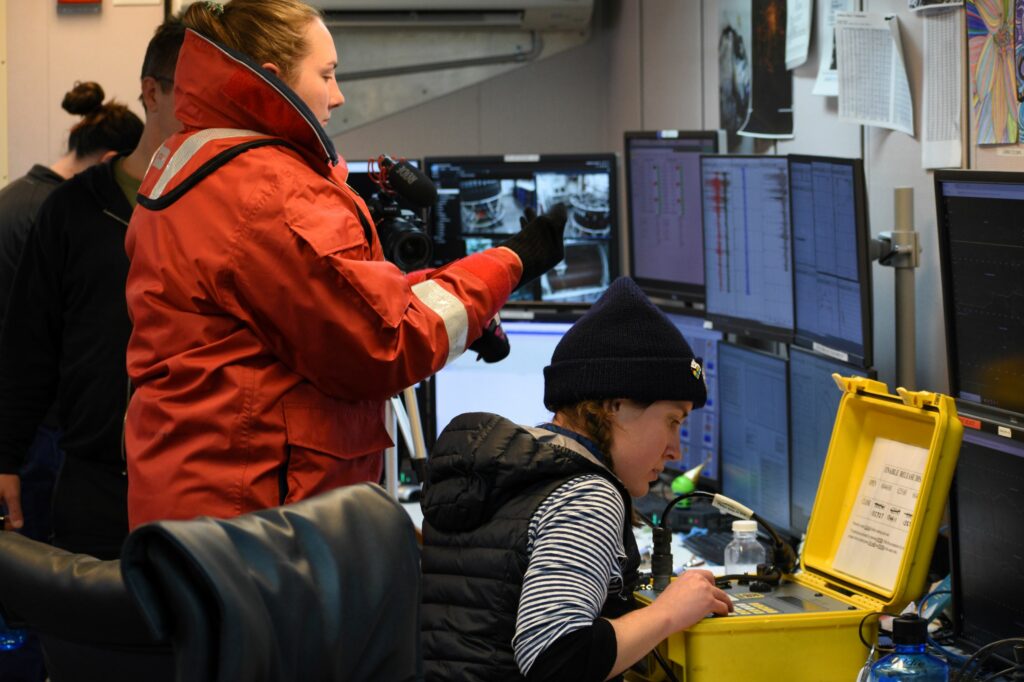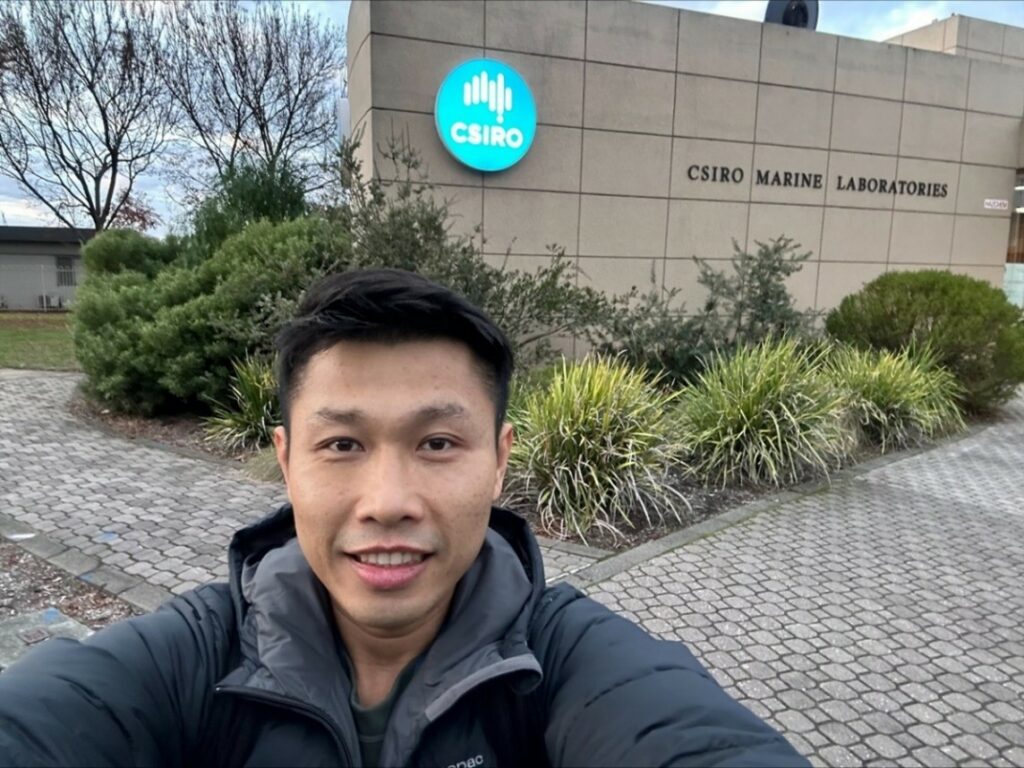
Applications are open for 2026 CSIRO-UTAS Studentships!
The CSIRO-UTAS Studentships provide high achieving University of Tasmania (UTAS) students in their final year of undergraduate study (including Honours) the opportunity to work with Australia’s national science agency, CSIRO, across a range of projects and discipline areas.
Starting your Studentship in February 2026, you will receive $11,000 to work the equivalent of two days a week across Semester 1 and Semester 2 (including mid-term break). All projects are located on-site at CSIRO Marine and Atmospheric Research in Hobart.
Successful applicants may also like to consider enrolling in KAA315 STEM Work Integrated Learning at UTAS in Semester 1 or Semester 2, 2025 if they wish to combine their Studentship with their studies.
Applications should be submitted by 5.00 pm, 24th October 2025.
What are the CSIRO-UTAS Studentships?
The CSIRO-UTAS Studentship program is an initiative of the Centre for Antarctic and Southern Ocean Technology (CAST). The aim of CAST is to advance Antarctic and Southern Ocean research by enabling collaborative effort in technology and engineering innovation and development, education and training, and the sharing of resources.
Previous recipients of our Studentships and information about their projects can be viewed on CAST News here.
How to Apply
To apply for a 2026 CSIRO-UTAS Studentship please send an application with the following:
- A paragraph outlining your interest in the CSIRO-UTAS Studentship program, your goals for the future, and which project(s), from the projects listed below, you wish to apply for. You may nominate up to two projects you wish to be considered for. Separate applications must be submitted for each project.
- Your UTAS academic transcript.
- Your Curriculum Vitae (CV).
Applications should be emailed to claire.mulhall@csiro.au by 5.00pm, 24th October 2025.
If you have any questions about the CSIRO-UTAS Studentship program, the projects, or your eligibility, please contact sm-cast_secretariat@utas.edu.au.
Shortlisted applicants will be contacted by CSIRO in early December and invited for an interview.
2026 Studentship Projects
The following projects are available in 2026. There is one placement per project.
| 1. Developing automated metadata pipelines for publication to the Data Access Portal The Information & Data Centre (IDC) provides data engineering and publication services to the Marine National Facility and various teams throughout CSIROs Environment Research Unit. As part of this service, the IDC generates metadata records associated with each published dataset to adhere with FAIR (Findable, Accessible, Interoperable, Reusable) principles. The student will be developing software to automate the process of creating and uploading metadata records to the Data Access Portal, and incorporating their solutions into a containerised data orchestration platform to test, monitor, and validate the process. Depending on the students interest, the project also has opportunities to expand into utilising Large Language Models (LLMs) for validation and enhanced templating, or automating other critical processes. | – Software Engineering – Data Engineering – Computer Science | David Webb – Information and Data Centre |
| 2. Software development of in-house built products and solutions used across Marine National Facility Software development team handles various – mostly internal – projects supporting different teams across Marine National Facility and Environment. They range in scope as well as application type so the student will get involved in project(s) directly interfacing with a physical instruments as well as projects which will mainly be focusing on a data processing. This generally involves a full-stack development and involvement in all steps of a software development cycle. | – Software Engineering – Computer Science – Software development projects management | Jakub Razak – Software |
| 3. Processing CSIRO-AusSeabed bathymetry datasets through the ASB pipeline CSIRO’s Geophysical Survey and Mapping team (GSM) has developed a data management pipeline that allows bathymetry data to be delivered effectively to the national AusSeabed program. The student will learn how to process bathymetry datasets (using software such as Caris) and apply/develop scripts (such as python) to enhance the pipeline using Github. Their main task will be to publish the Southern Surveyor voyages (2000-2013). | – Marine Science – Earth Science – Geospatial Data Management | Francisco Navidad – Geophysical Survey & Mapping |
| 4. Optimisation of IMU for Ocean Physics The development of commercial and recreational autonomous platforms like drones and Autonomous Underwater Vehicles (AUV) has increased exponentially over the last couple of years. These platforms rely heavily on the use of an inertial measurement unit (IMU) to determine the platform’s specific force, angular rate, and orientation. It is an electronic device that interprets data from fundamental sensors like accelerometers, gyroscopes, and magnetometers to derive movement and orientation. The student will compare the performance of a range of commercially available IMU sensors. This testing scenario and equipment will be designed by the student and may include field work at sea. The student will also develop a suite of software tools to perform IMU functionality by converting data from fundamental sensors into movement and orientation. | – Electronic Engineering – Software Engineering – Mechatronics Engineering – Mechanical Engineering | Jacques Malan – Electronics Engineering |
| 5. Enhancing stereo imagery processing for spatial mapping and size measurement of handfish The marine autonomy team is developing post-mission analysis tools to support ecological research. This project focuses on improving the processing pipeline for stereo imagery of endangered handfish species, collected by autonomous underwater vehicles (AUVs) and remotely operated vehicles (ROVs). Students will develop and test methods for mapping sighting locations and extracting fish measurements from these imagery datasets. The solution developed in this project will feature: • Workflow design to automate processing of stereo imagery for spatial mapping and measurement tasks. • Integration of computer vision techniques for detection and measurement of handfish. • Visualisation tools to support ecological interpretation of processed data. Students will leverage existing algorithms for object detection and measurement in stereo imagery and develop a streamlined processing pipeline. Data analysis from field deployments will also be undertaken, with outputs including recommendations for methods and practices suited to ongoing monitoring of handfish populations. | – Electronic Engineering – Software Engineering – Computer Science | Hui Sheng Lim – Electronics Engineering |
| 6. Optimising algorithm for real-time deployment on autonomous marine systems The marine autonomy team is developing advanced algorithms for path planning under uncertainty, using techniques such as Monte Carlo Tree Search (MCTS). The algorithm, originally implemented in Python, is computationally demanding and must be optimised for deployment on real-world autonomous marine platforms with limited onboard resources. This project focuses on improving the efficiency of the existing codebase to enable faster decision-making in the field. The student will work with both the marine autonomy team in Hobart and the robotics team in Brisbane to explore different approaches for optimisation, which may include refining Python implementations, using Cython, or re-implementing performance-critical components in other languages (e.g. C++). The project will involve: • Profiling the current algorithm to identify computational bottlenecks. • Investigating and applying optimisation strategies across different programming approaches. • Benchmarking performance improvements under realistic workloads. • Producing recommendations and documentation for deployment on embedded systems. This project provides flexibility for students to experiment with different optimisation pathways while contributing directly to the readiness of autonomy algorithms for field operations. | – Mechatronic Engineering – Software Engineering – Computer Science | Hui Sheng Lim – Electronics Engineering |
Frequently Asked Questions (FAQs)
What are the eligibility requirements?
You should be commencing the final year of an undergraduate degree offered in Sciences and Engineering at UTAS in Semester 1 or Semester 2 next year.
I am commencing Honours next year. Am I eligible to apply?
Yes. If you are commencing Honours (e.g., BSc(Hons)) next year, or your Honours program is embedded in the final year of your undergraduate degree (e.g., BE(Hons)), you are eligible to apply.
I will be graduating at the end of Semester 1. Am I eligible to apply?
Applicants graduating mid-year may still be eligible. Intending applicants should contact CSIRO to discuss their preferred project(s). It may be possible, for example, for the project objectives to be reduced in scope and completed in a shorter period.
Is my degree eligible? What units should I be studying?
You must be enrolled in an undergraduate degree offered by Sciences and Engineering at UTAS. There are no specific prerequisite units for the studentships, but you should be studying in an area relevant to the discipline in which the CSIRO projects are offered. The projects and discipline areas vary from year to year.
Do I need a minimum GPA?
All students are eligible to apply if they meet the eligiblity requirements. A minimum grade point average (GPA) is not required.
Do I have to enrol in KAA315?
You do not have to enrol in KAA315 STEM Work Integrated Learning to undertake a CSIRO Studentship, but it is an option you might like to consider. Contact the KAA315 Unit Coordinator if you would like to know more about KAA315 and whether it can be counted towards your graduation requirements.
Are international students eligible to apply?
Yes.
Can I apply for more than one CSIRO-UTAS Studentship project?
Yes. You can nominate up to two different projects when you apply for a studentship, but if your application is successful you will only undertake one project.
When will I know the outcome of my studentship application, and if it’s successful when will I start my project at CSIRO?
CSIRO will contact shortlisted applicants by early December to discuss the project(s) they have applied for and their suitability. Successful applicants be notified before the end of the year and undergo CSIRO onboarding in January. Onboarding is mostly done online and then students are inducted to on-site during the first week of their placement. Placements commence in February.
What is the duration of the studentship and how many hours a week will I be working?
Studentships are spread approximately across the academic year, commencing in February and typically concluding in November. Normal working hours (spread as 60 days across the calendar year) apply or are as agreed by UTAS, CSIRO and the student.
What is the value of the scholarship and how am I paid?
Scholarships amounts are $AUD 11,000 in total, paid fortnightly by UTAS when you start your project (i.e., 20 x $550 payments). A living allowance and additional expenses may also be paid by CSIRO to the student where applicable to the project.
What happens if I withdraw from my degree before the end of the studentship?
You must remain enrolled in your degree at UTAS for the duration of the studentship or your scholarship payments, the studentship and access to CSIRO facilities may be terminated.
Is my scholarship taxable?
Your scholarship may be taxable.
UTAS can provide general information about scholarships and tax that may be of assistance; however, the University and CSIRO cannot advise you directly as taxation depends on individual circumstances.
The Australian Taxation Office (ATO) has an online tool to help you determine if your scholarship is taxable.
If you require further advice about taxation, please contact the ATO directly or your tax advisor.
Am I considered a CSIRO or UTAS employee?
No. Students undertaking a CSIRO-UTAS Studentship are not considered employees.



